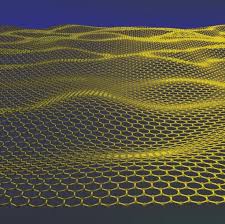
Graphene is a perfect 2D crystal of covalently bonded carbon atoms and forms the basis of all graphitic structures. (c) Photo: Costas Galiotis
FORTH/ ICE-HT and Dept. Materials Science, University of Patras
Time and time again we’ve hailed on ZME Science the cultural and scientific advances graphene is about to bring to humanity. It’s the strongest material known so far, while also being the lightest, it can be magnetic and – something of uttermost important to science – it’s the best electrical conductor that we know of. The latter also comes with a curse; one that electrical engineers have been trying to dispel for years, only to go through arduous sleepless nights. Building working graphene transistors is imperious for technology’s grand design of the future, but the thing with a graphene transistors is that you can’t turn it off. Now, if you know your basic electrical engineering you know that this means graphene’s useless in this case, despite the numerous and tremendous benefits it could provide.
Yup, it’s that conductive! Scientists at University of Riverside, California (UCR) , however, may have finally developed a work-around after they published a paper in which they demonstrate a graphene transistor circuit that can switch on and off by exploiting a counter-intuitive effect called negative resistance – we’ll get to that in a minute.
“The obtained results present a conceptual change in graphene research and indicate an alternative route for graphene’s applications in information processing,” the led by Guanxiong Liu write.
The de facto industry standard for building just about any electronics today is silicon. Now, as faithful and reliable silicon has proven to be along the decades, it’s soon becoming obsolete. Miniaturization has come a long way, but there’s only so much you can squeeze over such a limited surface. Most industry pundits think that the downscaling of silicon chip technology cannot extend much beyond 2026.
Graphene: the transistor
Technically, from there on graphene research should become reliable enough to enter mass manufacturing and replace silicon in the industry. When transistors are concerned, however, graphene has one major flaw – it doesn’t have a bandgap. There’s no energy range in this material where electron states can’t exist or for a transistor to practically function it needs to switch current.
To make this work, you’d need to hoax graphene into working like a semiconductor – electrons cannot flow at low energy and so the material behaves as an insulator. With this in mind, several attempts have been made of creating an artificial graphene band gap using methods such as applying electric fields, doping with atoms or by stretching and squeezing the material. These techniques, however, proved to render only modest results. Practical digital circuits require a band gap on the order of 1 eV at room temperature, but he best efforts with graphene have produced a few hundred meV at best.
Liu and colleagues however turned to an entirely different approach by exploiting what’s referred to as negative resistance, an effect in which a current entering a material causes the voltage across it to drop. Various groups, including this one at Riverside, have shown that graphene demonstrates negative resistance in certain circumstances.
Sleepless nights into sweet dreams for graphene scientists
If you exploit these voltage drops you can perform logic and enable switching. Liu and co demonstrate the effectiveness of their approach by designing a graphene-based circuit that can match patterns and show that it has several important advantages over silicon-based versions. For starters, logic gates built from these inverted transistors could be much denser, more efficient at some tasks, and operate at terrifying speeds over 400GHz.
The only issue that remains now is maybe the most challenging: actually building an inverted graphene transistor circuit. For now, the researchers have demonstrated experimentally that negative resistance occurs in graphene, the rest will remain to be determined. Still, their work is extremely promising and shows off an elegant and creative solution to a pestering problem that has been giving engineers headaches for nearly ten years since graphene has become truly hot.
Even so, graphene is great for electronics. Just a while ago, ZME Science wrote how graphene light sensors are 1,000 more sensitive, can reduce CPU temperature by 25% or multiply light.
Findings were reported in a paper published in the journal Mesoscale and Nanoscale Physics.









